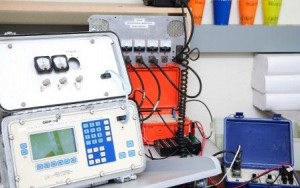Determining core sample IP response,
resistivity and conductivity laboratory measurements
 Measurements for induced polarization response and resistivity are made in the time-domain mode using a technique developed by Newmont Exploration, Ltd.
Measurements for induced polarization response and resistivity are made in the time-domain mode using a technique developed by Newmont Exploration, Ltd.
Using an 8.0 second period (2 seconds on positive, 2 seconds off, 2 seconds on negative, 2 seconds off), the IP response is integrated over a window from 0.45 to 1.1 seconds during the off-time.
These procedures are performed simultaneously using a Zonge GDP series geophysical data processor, and a constant current transmitter (as low as 100 nanoamps). IP measurements are made in the time domain for a complete cycle of 8.0 seconds (two transmitter pulses) averaged over 16 cycles. The reported chargeability data may be transformed to the normalized standard Newmont IP unit (M331 msec) by multiplying by 1.87. The resistivity values are in ohm-meters.
Considerations
The procedure requires specially prepared cores, bicylindrical cores or cubed samples. Moisture saturation under vacuum is required for reliable data. If the received samples are moderately dry, such as surface samples, vacuum impregnation with distilled water is performed before determination of the electrical properties. As a consequence, the reported resistivities for these samples may not be truly representative of the rock in situ but will depend on the amount of water ingested into the rock pores. If the samples are saturated with interstitial water upon receipt they may be run without impregnation with water.
Interpreting the measured results
IP values determined in the laboratory on small core samples are generally representative of macroscopic IP responses and should agree well with surface measurements.
Rock resistivities measured in the laboratory are normally not indicative of the macroscopic resistivities inferred from surface measurements. The values are typically higher than observed field resistivities. This is because small core samples do not adequately represent the large-volume average resistivities of the ground, which can be influenced by fractures and faults containing mineralized solutions.
Fresh drill-core samples, however, which have not been exposed to the air or elevated temperatures will sometimes yield representative rock resistivities in the laboratory.
Conductivity
Conductivity measurements are performed on massive sulfide samples using lead-sulfide electrodes. The results are reported in Siemens/meter.
The samples are prepared by cutting parallel planar faces on each sample, maximizing the distance between the faces. Saturation with water is usually not necessary.


